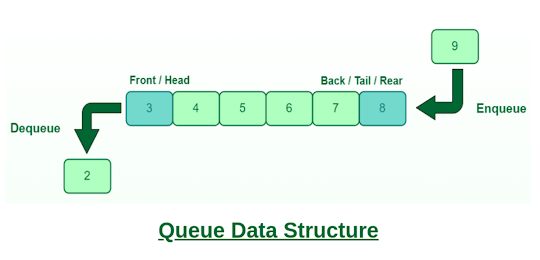Hello guys, today I am going to share another interesting question from Java interview, what is difference between Queue and Deque in Java. This question was asked to one of my reader in a recent interview with JP Morgan Mumbai and this is also a popular Java collection interview question. While he was able to answer the question, he wasn't able to convince interviewer so he asked me how to answer this question. So I am writing this post to share my answer on Queue vs Deque in Java. In the vast world of Java programming, the need to manage data efficiently often leads developers to specialized data structures.
Two commonly used structures for handling collections of elements are the Queue and the Deque (Double-ended Queue). While both share similarities, they serve distinct purposes and come with their own set of advantages and disadvantages.
Let's learn about the pros and cons of Queue and Deque in Java, explore examples, and discuss when to opt for each.
What is Queue in Java? First-In-First-Out (FIFO) Data Structure
A Queue follows the First-In-First-Out principle, resembling a line in a supermarket. The element added first is the one that's removed first. In Java, the Queue interface is implemented by various classes, including LinkedList and PriorityQueue.
Here's a basic example of Queue in Java:
import java.util.LinkedList;
import java.util.Queue;
public class QueueExample {
public static void main(String[] args) {
Queue<String> queue = new LinkedList<>();
// Enqueue elements
queue.add("Apple");
queue.add("Banana");
queue.add("Cherry");
// Dequeue elements
System.out.println(queue.poll()); // Output: Apple
System.out.println(queue.poll()); // Output: Banana
}
}You can see its very easy to use Queue in Java. The poll() method is used to deque elements from the Queue and it follows First In First Out or FIFO order.
And here is how a Queue looks like in Java:
Pros and Cons of Queue
Now, let's see pros and cons of Queue class in Java.
Pros:
Simple and Intuitive: The FIFO principle is easy to understand and implement.
Well-suited for Task Scheduling: Queues are often used in task scheduling and order-dependent processing.
Cons:
Limited Functionality: Traditional queues might not be efficient for scenarios requiring operations at both ends of the queue.
Now that you know what is Queue and when to use it as well as pros and cons of Queue data structure in Java, its time to see the Double Ended Queue or Deque in Java.
Deque in Java: A Versatile Double-Ended Queue
A Deque, short for double-ended queue, allows insertion and removal of elements from both ends. In Java, the Deque interface is implemented by classes such as ArrayDeque and LinkedList.
Here's a basic example of Dequeue in Java:
import java.util.ArrayDeque;
import java.util.Deque;
public class DequeExample {
public static void main(String[] args) {
Deque<String> deque = new ArrayDeque<>();
// Add elements at the beginning
deque.addFirst("Apple");
deque.addFirst("Banana");
// Add elements at the end
deque.addLast("Cherry");
// Remove elements
System.out.println(deque.pollFirst()); // Output: Banana
System.out.println(deque.pollLast()); // Output: Cherry
}
}You can see that Dequeue allows you to add or remove elements from both end. You can use addFirst() to add elements at front of the queue as well addLast() to add elements at the rear of the queue.
And here is how Dequeue look like in Java:
Pros and Cons of Deque
Now, let's jump into pros and cons of Dequeue in Java and find out when to use Dequeue in Java programs:
Pros:
Versatility: Deques allow operations at both ends, making them versatile for various scenarios.
Efficient Stacks and Queues: Deques can efficiently simulate stacks and queues, offering flexibility in implementation.
Cons:
Complexity: The additional functionality might be unnecessary in simpler use cases, introducing complexity.
When to Use Queue vs Deque in Java?
Now the big question comes when to use Queue and when to use Deque in Java:
Use Queue When:
Strict Order Matters: If you need to process elements in the order they were added, a Queue is a natural choice.
Simple First-In-First-Out Logic: When the logic is straightforward and involves only enqueue and dequeue operations.
Use Deque When:
Need for Versatility: If your application requires flexibility in adding or removing elements from both ends, a Deque is a better fit.
Efficient Stack or Queue Simulation: Deques can efficiently simulate the behavior of both stacks and queues, providing an optimal solution for various scenarios.
That's all in the difference between Queue and Dequeue in Java. In the dynamic landscape of Java programming, understanding the nuances of data structures is crucial for efficient and effective coding.
The choice between a Queue and a Deque boils down to the specific requirements of your application. If you need a straightforward FIFO structure, a Queue will serve you well.
On the other hand, if versatility and flexibility are paramount, opting for a Deque will enable you to handle a broader range of scenarios. Always consider the pros and cons, and let the nature of your data management needs guide your decision.
- How to use ArrayList and LinkedList in Java?
- How to sort a Map by values in Java 8
- Difference between HashSet, TreeSet, and LinkedHashSet in Java?
- How to convert List to Map in Java 8
- 50 Java Collections and Generics Questions with Answers
- How to use HashMap in Java?
- 21 Java HashMap Interview Questions with Answers
- 20 Java ArrayList Interview Questions with Answers
- 10 Free Courses to Learn Java Online
Thanks for reading this article so far. If you like this Queue vs Dequeue interview question, then please share it with your friends and colleagues. If you have any questions or feedback, then please drop a note. I will try to answer my best.


No comments:
Post a Comment
Feel free to comment, ask questions if you have any doubt.